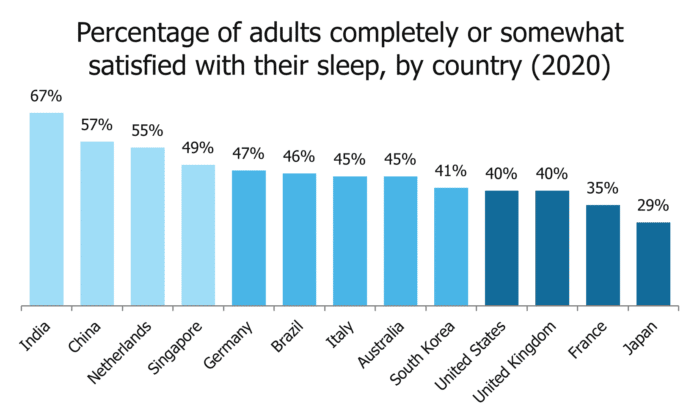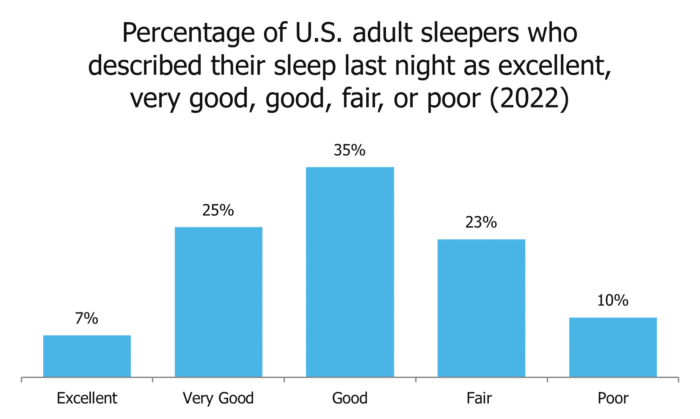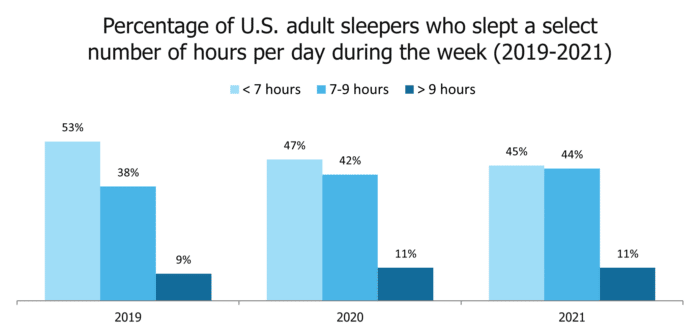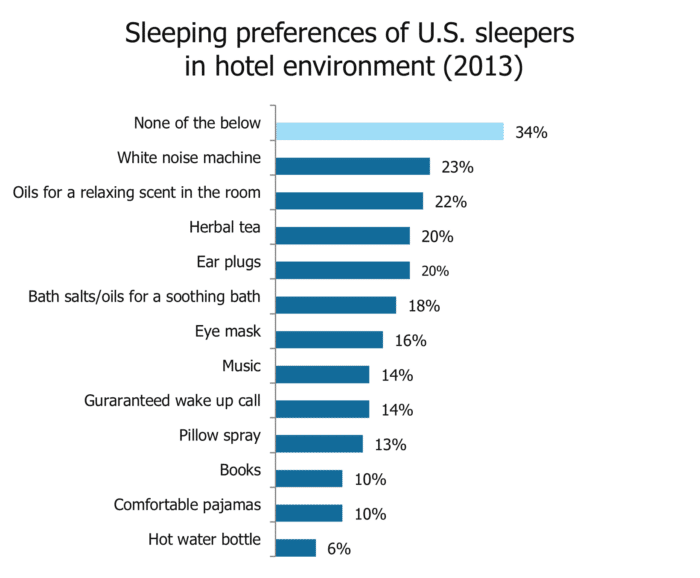Sleep Habits & Sleep Statistics (2022)

Written by: Derek Hales
Published on: June 20, 2022
Sleep is something that everyone needs, but doesn’t always come easily. In this analysis, we’re exploring the sleep habits and sleep behaviors across countries, genders, ages, and more.
We cover the following topics:
- Does sleep impact your mood & health?
- What countries get the best sleep?
- How well do adults sleep?
- What is the most common sleep problem?
- How important is sleep to men and women?
- Who gets the most sleep?
- What are the most popular sleep habits?
- How to improve hotel sleep?
- How to feel less sleepy?
Sleeping Habits & Statistics (Editor’s Picks)
- Sleep Impact: 49% of sleepers have reported sleep having the largest impact on their mood and whether or not they have a good day at work.
- Global Sleep Satisfaction: India has the highest sleep satisfaction, with 67% of sleepers being satisfied with their sleep. The U.S. has 40% of sleepers being satisfied and Japan snags the bottom spot with only a 29% satisfaction rating.
- Last Night’s Sleep: From a survey of adult sleepers in the U.S., 35% reported good sleep last night. 10% of sleepers reported “poor” sleep.
- Sleep Problems: 54% of all Americans report problems falling asleep, staying asleep, or both.
- Women & Sleep: Getting good sleep is a priority for 61% of women, while only 48% of men carry the same value.
- Gender Differences: Men and women average the same number of hours slept per night, 6.73 hours / night.
- Sleep by Generation: The Silent Generation (1928-1945) get the most sleep of any generation. Gen X gets the least sleep at only 6.54 hours / night.
- Sleeping in the Northeast: Adult sleepers in the Northeast get more sleep than any other U.S. region, 6.78 hours / night.
- Rise & Shine: 53% of Americans report waking up at the same time every morning (most of the time).
- Preference for White Noise: White noise machines are the most common sleep aid for those sleeping in a hotel. 27% of hotel sleeper use a white noise machine.
- Shake It Off: When faced with sleepiness, 62% of people choose to just “shake it off” as opposed to taking a tangible action (like food, exercise, drinks, or sleep).
Does sleep impact your mood & health?
Research suggests that sleep has the largest effect on your mood and whether or not you have a good day at work.
49% of U.S. adult sleepers stated that sleep has the biggest impact on both their mood and day at work, closely followed by health in general at 45%.
According to respondents, exercise and ability to have fun were also significantly impacted by sleep, at 31% and 30%, respectively.
23% of U.S. adults reported that sleep impacts how healthy they eat.

If you get enough sleep, you can feel it. Benefits of getting enough sleep include:
- Getting sick less often
- Staying at a healthy weight
- Lowering your risk for serious health problems
- Reducing stress and improving your mood
- Thinking more clearly
- Getting along better with people
- Making good decisions and avoiding accidental injuries
Sources: Casper, Gallup, Health, Statista
What countries get the best sleep?
In a global study of sleep satisfaction, the top countries for sleep satisfaction include:
- India: 67% satisfied
- China: 57% satisfied
- Netherlands: 55% satisfied
- Singapore: 49% satisfied
The countries with the poorest sleep satisfaction include:
- United States: 40% satisfied
- United Kingdom: 40% satisfied
- France: 35% satisfied
- Japan: 29% satisfied

How well do adults sleep?
In a survey of last night’s sleep, 35% of adult sleepers in the U.S. reported good sleep. Fewer sleepers fell at either extreme of the spectrum, with only 7% of sleepers sleeping excellently and 10% of sleepers sleeping poorly.

Sources: Casper, Gallup, Statista
What is the most common sleep problem?
Of sleepers who reported problems sleeping last night, the most common complaint at 28% is having trouble staying asleep (compared to trouble falling asleep).
Only 11% of sleepers had problems both falling asleep and staying asleep.
Surprisingly, 46% of U.S. adults sleepers reported “no trouble sleeping”, while only 40% indicated they were satisfied with their overall sleep.

Sources: Casper, Gallup, Statista
How important is sleep to men and women?
Among all adult sleepers in the U.S., 55% stated that getting good sleep on a typical weekday is a major priority.
Women clearly prioritize sleep more significantly compared to men. 61% of women indicated the sleep is a priority, compared to only 48% of men.

Sources: Casper, Gallup, Statista
Who gets the most sleep?
The following charts show data concerning who gets the most sleep in the United States. Data is broken down by gender, generation, and region.
From these results, we can draw the following conclusions:
- On average, women and men get 6.73 hours / night.
- The Silent Generation (1928-1945) gets the most sleep of any generation, averaging 6.97 hours / night.
- Adult sleepers in the northeast get more sleep than any other U.S. region, averaging 6.78 hours / night.
What gender gets the most sleep?
Most adults get 6-8 hours of sleep per night, with 27.5% of adults sleeping 7 hours per night. Despite differences in exact hour distribution, on average, both men and women get 6.73 hours of sleep per night.
33% of men get 8 hours of sleep or more per night, compared to only 31% of women.

What generation gets the most sleep?
The Silent Generation (1928-1945) gets the most sleep of any generation, averaging 6.97 hours / night.
Gen X (1965-1981) gets the least sleep each night, average only 6.54 hours / night.

Average number of hours of sleep per night by generation:
- Gen Z – 6.87 hours / night
- Millennials – 6.78 hours / night
- Gen X – 6.54 hours / night
- Baby Boomers – 6.60 hours / night
- Silent Generation – 6.97 hours / night
What U.S. region get the most sleep?
U.S. adults in the Northeast get the most sleep per night of any U.S. region, averaging 6.78 hours / night.
Lower temperatures can have a positive impact on sleep. The lower average temperature in the Northeast U.S. compared to other regions may be impacting region-wide sleep quality.
U.S. adults in the West and Midwest get the least sleep, both averaging 6.65 hours / night.

Average number of hours of sleep per night by region:
- Northeast – 6.78 hours / night
- Midwest – 6.65 hours / night
- South – 6.73 hours / night
- West – 6.65 hours / night
Nightly Sleep Duration Trends from 2019-2021
Over the span of three years, the chart below documents the average number of hours U.S. adult sleepers get.
This trend shows a decrease in sleepers getting less than 7 hours of sleep and a slight increase of sleepers getting between 7-9 hours of sleep.

One possible conclusion is that the pandemic’s increase in work-from-home occupations may be affording more adults additional time for sleep, as a result of time saved from commuting and morning routine.
Sources: Statista 1, Statista 2, Statista 3, Statista 4, YouGov, WebMD
What are the most popular sleep habits?
53% of adult sleepers in the U.S. have a tendency to wake at the same time every morning and 43% go to bed at the same time every night.
Studies show that these two techniques alone can improve the body’s natural circadian rhythm.
24% of U.S. adult sleepers are able to fall asleep the moment their head hits the pillow.
93% of U.S. adult sleepers don’t wear socks to bed.

How to improve hotel sleep?
For U.S. hotel sleepers, 23% utilized a white noise machine, 20% employed ear plugs, and 16% opted for an eye mask.
Oils with a relaxing scent were utilized 22% of the time, while drinking herbal tea came in at 20%, followed by bath salts and oils at 18%.
Books and comfortable pajamas were among the least utilized preferences, coming in at 10%, with the classic hot water bottle being the least employed tactic at only 6%.

Sources: Statista
How to feel less sleepy?
When you’re sleepy and want to feel refreshed, try one of the sleep remedies below. When faced with sleepiness, the most popular action to take is to simply “shake it off”, with 62% of sleepers preferring this approach.
A quick breath of fresh air is the second most common method at 33%.
With respect to food and drink consumption, coffee and sodas were the most common, at 33% and 30%, respectively. 22% of U.S. adults reached for a sugary snack, while 11% went for a stick of gum.
Only 6% of sleepers resorted to prescription or OTC medications when drowsy.

Sources: National Sleep Foundation, Statista
Final Thoughts
No matter your age, gender, region, job, or pay grade, the truth is we all need sleep. I hope you found these sleep statistics and trends interesting and helped you to learn more about sleep behavior and associated habits.
Want to learn more or have a recommendation for our next analysis? Drop us a message, we’d love to keep this conversation going!


